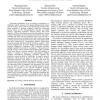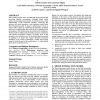1151 search results - page 209 / 231 » The role of game theory in human computation systems |
CCECE
2006
IEEE
14 years 4 months ago
2006
IEEE
Presenting information to an e-learning environment is a challenge, mostly, because ofthe hypertextlhypermedia nature and the richness ofthe context and information provides. This...
PODS
2005
ACM
14 years 10 months ago
2005
ACM
Suppose we have a large table T of items i, each with a weight wi, e.g., people and their salary. In a general preprocessing step for estimating arbitrary subset sums, we assign e...
IMC
2009
ACM
14 years 4 months ago
2009
ACM
With over half a billion users, Online Social Networks (OSNs) are the major new applications on the Internet. Little information is available on the network impact of OSNs, althou...
AVI
2006
13 years 11 months ago
2006
Mixed reality systems seek to smoothly link the physical and data processing (digital) environments. Although mixed reality systems are becoming more prevalent, we still do not ha...
AAMAS
2005
Springer
13 years 10 months ago
2005
Springer
Cooperative multi-agent systems are ones in which several agents attempt, through their interaction, to jointly solve tasks or to maximize utility. Due to the interactions among t...


